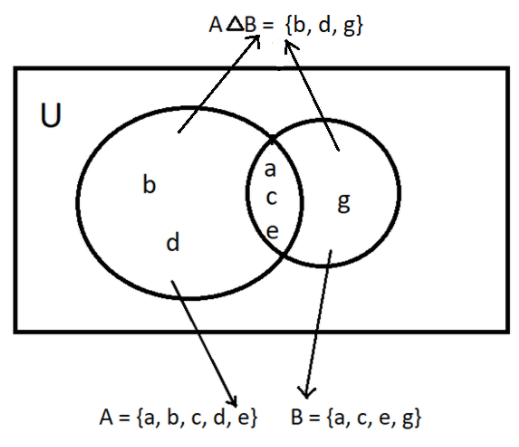
Find \[A\Delta B\] and draw Venn diagram when:
\[A = \left\{ {a,b,c,d,e} \right\}\] and \[B = \left\{ {a,c,e,g} \right\}\]
Answer
481.2k+ views
Hint: In this particular question find the elements that are not common to the set A and B because \[A\Delta B\] is a set of all elements which are not in both sets (i.e. uncommon elements).
Complete step-by-step solution:
Now as we know that Venn’s diagram is a diagram representing mathematical or logical sets pictorially as circles or closed curves within an enclosing rectangle (the universal set), and common elements of the set are represented by intersections of the circle or closed curves.
So, now let us first draw the Venn’s diagram for the set A and B.

As we can see from the above Venn’s diagram that the element {b, d, g} does not belong to both the sets or in other words each of the elements of set {b, d, g} either belong to set A or set B.
So, \[A\Delta B = \left\{ {b,d,g} \right\}\]
Because \[A\Delta B\] is the set of all elements that are not present in all sets.
Hence, \[A\Delta B = \left\{ {b,d,g} \right\}\].
Note: Whenever we face such types of questions the key concept recall is that if there are two sets X and Y then \[X\Delta Y\] will be set having elements that are not present in both the sets X and Y. So, we can directly find the value of \[X\Delta Y\] by applying the formula that is \[X\Delta Y = \left( {X \cup Y} \right) - \left( {X \cap Y} \right)\], where \[\left( {X \cup Y} \right)\] will be the set of all elements of set X and Y. While \[\left( {X \cap Y} \right)\] will be the set of common elements of set X and Y. This will be the easiest and efficient way to find the solution to the problem if the Venn’s diagram is not asked to draw.
Complete step-by-step solution:
Now as we know that Venn’s diagram is a diagram representing mathematical or logical sets pictorially as circles or closed curves within an enclosing rectangle (the universal set), and common elements of the set are represented by intersections of the circle or closed curves.
So, now let us first draw the Venn’s diagram for the set A and B.

As we can see from the above Venn’s diagram that the element {b, d, g} does not belong to both the sets or in other words each of the elements of set {b, d, g} either belong to set A or set B.
So, \[A\Delta B = \left\{ {b,d,g} \right\}\]
Because \[A\Delta B\] is the set of all elements that are not present in all sets.
Hence, \[A\Delta B = \left\{ {b,d,g} \right\}\].
Note: Whenever we face such types of questions the key concept recall is that if there are two sets X and Y then \[X\Delta Y\] will be set having elements that are not present in both the sets X and Y. So, we can directly find the value of \[X\Delta Y\] by applying the formula that is \[X\Delta Y = \left( {X \cup Y} \right) - \left( {X \cap Y} \right)\], where \[\left( {X \cup Y} \right)\] will be the set of all elements of set X and Y. While \[\left( {X \cap Y} \right)\] will be the set of common elements of set X and Y. This will be the easiest and efficient way to find the solution to the problem if the Venn’s diagram is not asked to draw.
Recently Updated Pages
Can anyone list 10 advantages and disadvantages of friction

What are the Components of Financial System?

How do you arrange NH4 + BF3 H2O C2H2 in increasing class 11 chemistry CBSE

Is H mCT and q mCT the same thing If so which is more class 11 chemistry CBSE

What are the possible quantum number for the last outermost class 11 chemistry CBSE

Is C2 paramagnetic or diamagnetic class 11 chemistry CBSE

Trending doubts
The correct order of melting point of 14th group elements class 11 chemistry CBSE

One Metric ton is equal to kg A 10000 B 1000 C 100 class 11 physics CBSE

What is the specific heat capacity of ice water and class 11 physics CBSE

Proton was discovered by A Thomson B Rutherford C Chadwick class 11 chemistry CBSE

Why does niobium have a d4s1 electron configuration class 11 chemistry CBSE

Describe the blood vascular system of Herdmania class 11 biology CBSE




